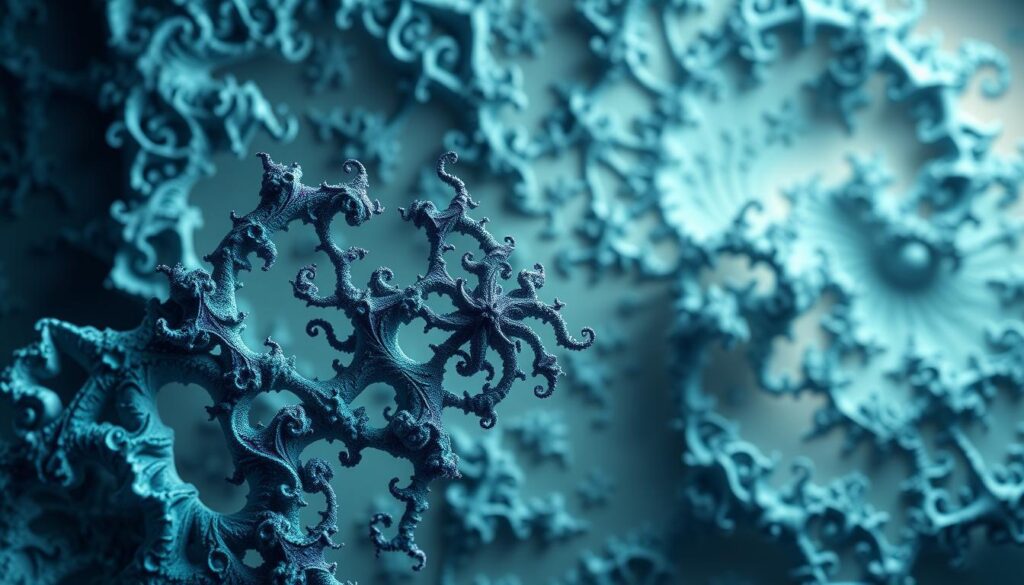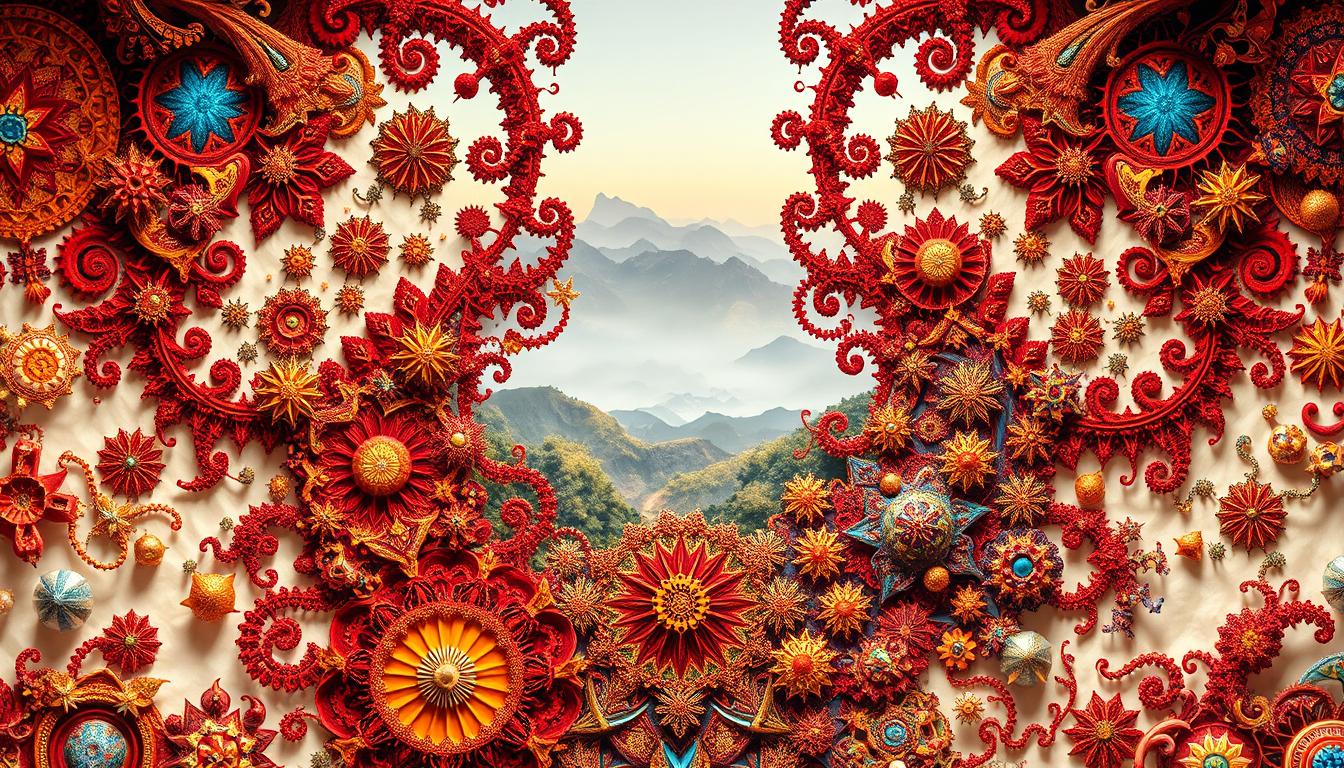Fractal geometry is a complex mix of shapes and patterns. It was made famous by Benoit Mandelbrot. This concept is deeply rooted in indigenous lessons on fractal geometry. By looking at fractals and nature, we learn about Africa’s early math achievements. Before the Western world acknowledged it, indigenous people had profound geometry knowledge. These mathematical concepts not only show nature’s beauty. They also reflect indigenous cultures’ wisdom and views. This journey into ancestral knowledge will link fractal patterns with cultural traditions. It shows their role in understanding the natural and cosmic worlds.
Understanding Fractal Geometry
Fractal geometry is a fascinating area that shows us the complex but beautiful patterns in nature. The definition of fractals talks about shapes that split into smaller versions of themselves. This idea is called self-similarity. It helps us understand the detailed patterns that make up our world. So, it’s crucial in both math and science.
Definition and Characteristics of Fractals
Fractals have unique features like scaling and recursion. No matter how close you look, fractal patterns show deep details. We see examples in nature like coastlines, trees, and clouds. Traditional geometry can’t fully describe their complexity. These features are useful in many areas, including computer graphics, environmental science, and building design.
Historical Context of Fractal Geometry
The study of fractals grew a lot in the 20th century, thanks to Benoit Mandelbrot. He created a math framework for these patterns. In 1975, he named this concept “fractal.” This allowed researchers to dive deep into how fractals work in many fields. Cultures around the globe, especially in Africa, have used fractal concepts in architecture and more. They showed an early grasp of these math ideas before they were officially defined.

Indigenous Teachings on Fractal Geometry
Indigenous lessons show us how nature’s patterns and our world connect. They point out the role of fractal geometry in daily life and traditions. African societies use fractal concepts to grasp their culture and community structures.
Connection to Natural Patterns
Indigenous wisdom links closely to nature’s patterns, seen in ecosystems. These insights reveal a wise use of resources. Village designs often reflect fractal shapes, leading to a balance with nature. Practices like contour farming show this alignment, showcasing deep biodiversity knowledge.
Cultural Significance in African Societies
Fractals mean more than patterns in African cultures. They define identity in art, clothes, and ceremonies. Spiritual symbols with fractals speak to deeper truths and unity. By understanding these teachings, we see how math and culture merge. This deepens our view of art and social bonds.
Historical Contributions of African Civilizations
Long before colonial times, African civilizations were making big strides in math. This was mostly through their buildings and art. The complex designs in African architecture show they really understood geometry. Their work shows how important math was in different cultural forms.
Mathematics in Pre-Colonial Africa
Before the colonials arrived, Africans used math for trade, farming, and building. This math helped make daily life easier and richer culturally. For example, villages used geometric patterns for planning and organizing communities.
The Role of Fractals in Architecture and Art
African buildings show fractals, a type of design that repeats across different scales. These designs tell stories and reflect the values of a community. Fractals make the art and buildings more beautiful and are key to African heritage. This shows the clever use of math in African cultures.
Fractals in the Natural World
Fractals in nature show the universe’s beauty and complexity. They reflect patterns that repeat on different scales. These examples help us understand how life forms and structures are connected. They make us appreciate biodiversity and life’s balance more.
Examples of Fractals in Nature
Fractals appear in many parts of nature:
- Branching structures of trees and shrubs, where each limb mirrors the shape of the whole.
- River systems that reveal complex patterns formed by meandering flows and tributaries.
- Cloud formations displaying self-similar patterns that vary in scale from tiny wisps to expansive cumulus clouds.
- Coastlines and mountain ranges exhibiting irregular shapes yet consistently fractal in their representations.
Understanding Ecosystems through Fractal Patterns
Fractals help us understand ecosystem patterns. They show the connections between organisms and their habitats. By looking at fractals, researchers learn about resource distribution and population changes. This reveals how all living things are connected.
The Impact of Ron Eglash’s Research
Ron Eglash’s study of African fractals has changed how we see math and native design together. His key work shows how African traditions use fractal geometry principles, now known in modern computing. Through his studies, Eglash reveals the deep value of native wisdom and its importance today.
African Fractals: Modern Computing and Indigenous Design
In “African Fractals: Modern Computing and Indigenous Design,” Eglash explores how native designs used fractal ideas way before modern math came about. This link between native design and fractals leads to new ideas in today’s computing world.
Bridging Mathematics and Indigenous Knowledge
Eglash’s work builds a bridge between the complex world of computing and the real practices of indigenous people. This link shows the role of math in African cultures, displaying a deep knowledge of fractals. This knowledge touches many areas of life, art, and technology.
Fractal Geometry in Indigenous Cosmology
Fractal geometry is key in understanding indigenous views of the universe. It blends math with spiritual beliefs. This blend shows how different cultures see the cosmos, focusing on infinity and connection. The use of fractals in spiritual ideas shows a deep bond between math and the universe’s secrets.
Spiritual and Philosophical Perspectives
Indigenous views often go beyond just the physical world. They include ideas of patterns and cycles in nature, similar to fractals. These concepts are important in their rituals and stories. They help illustrate the cosmos and our path within it.
The Interplay of Mathematics and Cosmology
Looking at the universe through fractals helps indigenous peoples understand their place in it. The repeating shapes in nature and stories show how well they know fractal ideas. This connection makes it clear how math can uncover deeper truths about life and the universe.
Case Studies of Fractal Applications
Looking at African villages, we see amazing design and art closely linked with fractals. These examples show how old wisdom uses fractals in ways that are smart, beautiful, and full of culture. By diving into specific cases, we understand how these traditional methods are still valuable today.
Architectural Designs in African Villages
In African villages, buildings often show fractal geometry. This is not just for looks—it’s very practical too. These patterns, similar to those found in nature, make the buildings fit well with different environments. The whole village blends smoothly with nature, making every space feel natural and connected.
Fractals in Traditional Craftsmanship
Fractal applications show the creativity of traditional crafts. In weaving, pottery, and carving, artisans include fractal patterns. This results in unique items that have deep cultural meaning. These beautiful designs do more than just look good. They help keep the community and its traditions alive, generation after generation.
Contemporary Relevance of Indigenous Fractal Knowledge
Indigenous fractal knowledge is very important today. It helps us understand nature’s connections better and improve how we teach different subjects. By adding indigenous math to our lessons, we teach students new ways to see the world. They learn to appreciate nature’s complex patterns too.
Incorporating Indigenous Wisdom in Modern Education
Using indigenous wisdom in education makes learning more complete. It can be done in several ways:
- Using fractal geometry to show how math, art, and science are connected.
- Developing lessons that show how indigenous stories and practices help us understand nature.
- Encouraging problem-solving that uses knowledge from traditional ways of living with nature.
This approach broadens students’ views. It helps them see beyond the usual school subjects and connects them with the natural world’s cycles.
Potential for Addressing Environmental Challenges
Indigenous knowledge is key in solving environmental problems. Here’s how:
- Fractal patterns in nature guide us in farming sustainably within our ecosystems.
- Learning from indigenous building designs leads to more eco-friendly architecture.
- Supporting projects led by communities with traditional conservation knowledge can make a big difference.
This approach not only supports communities but also raises environmental awareness. It shows that old knowledge can solve new problems.
Conclusion
Exploring indigenous teachings on fractal geometry uncovers deep meanings in their culture and math. These teachings link life, nature, and art in their communities. By seeing the patterns in nature and art, we learn a lot from these old traditions.
The history of fractal geometry, especially in African cultures, shows how old practices have shaped today’s math and design. Looking back at these teachings helps us value their impact on math. It also shows why it’s important to mix indigenous knowledge with today’s learning methods.
We should pay more attention to indigenous wisdom in math and science talks. Fractal geometry’s lessons urge us to look at nature wholly. It encourages us to value indigenous cultures’ different viewpoints in solving current issues and keeping their unique stories alive.



